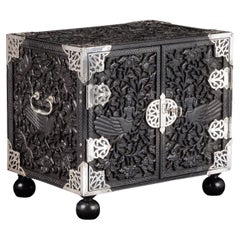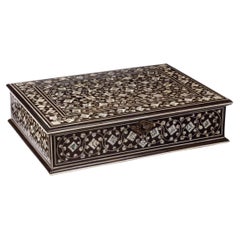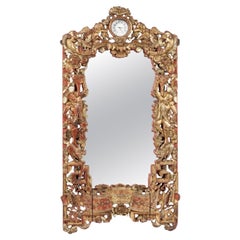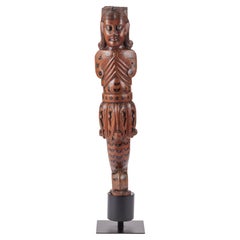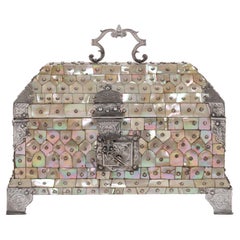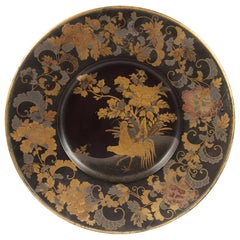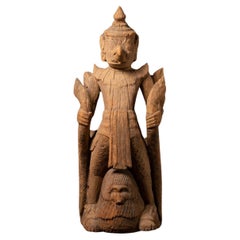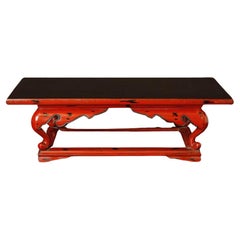Zebregs&Röell More Asian Art, Objects and Furniture
to
8
8
6
2
8
4
3
2
2
8
6
5
2
1
8
8
8
17th century colonial Sinhalese ebony two-door cabinet with silver mounts
Located in Amsterdam, NL
A splendid Dutch-colonial Sinhalese ebony two-door cabinet with silver mounts
Sri Lanka, Kandy, 2nd half 17th century, the mounts later
The cabinet with a central drawer with hidde...
Category
Antique 17th Century Sri Lankan Dutch Colonial Jewelry Boxes
Materials
Silver
18th century Dutch-Colonial ‘Vizagapatam’ pen-engraved bone inlaid ebony box
Located in Amsterdam, NL
A large Indian Colonial ‘Vizagapatam’ pen-engraved bone inlaid ebony box
Masulipatnam or Vizagapatam, 2nd half 18th century
H. 10.8 x W. 47 x D. 34 cm
...
Category
Antique Late 18th Century Indian Dutch Colonial More Asian Art, Objects ...
Materials
Bone, Ebony
Charming carved gilt-wood Chinese export mirror frame watch-stand with Europeans
Located in Amsterdam, NL
A charming carved giltwood Chinese export mirror frame with a watch-stand
Canton, Qing Dynasty, early 19th century
H. 65 x W. 34.5 cm
At the top of the frame, two angels are suppo...
Category
Antique 19th Century Chinese Qing Wall Mirrors
Materials
Giltwood
Splendid Indo-Portuguese Colonial Sculpture of Nagini from Goa, 17th Century
Located in Amsterdam, NL
A fine Indo-Portuguese inlaid teak wood figure of Nagini
India, Goa, 17th century
Measure: H. 55 cm
(with stand, and with ring for wall hanging)
The sculpture can be perceived as such but probably is one of four legs of an Indo-Portuguese contador...
Category
Antique 17th Century Indian Jewelry Boxes
Materials
Teak, Ebony
16th-Century Indo-Portuguese Colonial Mother-of-pearl Gujarat Casket
Located in Amsterdam, NL
An exceptional Indo-Portuguese colonial mother-of-pearl veneered casket with silver mounts
India, Gujarat, 2nd half of the 16th century, the silver mounts Goa or probably Lisbon
Measures: H. 16 x W. 24.6 x D. 16.1 cm
An exceptional Gujarati casket with a rectangular box and truncated pyramidal lid (with slopes on each side and a flat top) made from exotic wood, probably teak (Tectona grandis), covered with a mother-of-pearl mosaic. The tesserae, cut from the shell of the green turban sea snail (Turbo marmoratus, a marine gastropod) in the shape of fish scales, are pinned to the wooden structure with silver ball-headed nails. The casket is set on bracket feet on the corners. The masterfully engraved decoration of the silver mounts follows the most refined and erudite Mannerist repertoire of rinceaux and ferroneries dating from the mid-16th century. The high quality and refinement of the silver mounts and, likewise, the silver nails that replaced the original brass pins used to hold the mother-of-pearl tesserae in place indicate the work of a silversmith probably working in Lisbon in the second half of the 16th century.
The Indian origin of this production, namely from Cambay (Khambhat) and Surat in the present state of Gujarat in north India, is, as for the last three decades, consensual and fully demonstrated, not only by documentary and literary evidence - such as descriptions, travelogues and contemporary archival documentation - but also by the survival in situ of 16th-century wooden structures covered in mother-of-pearl tesserae. A fine example is a canopy decorating the tomb (dargah) of the Sufi saint, Sheik Salim Chisti (1478-1572) in Fatehpur Sikri in Agra district in the state of Uttar Pradesh, north India. This is an artistic production, geometric in character and Islamic in nature, where usually the mother-of-pearl tesserae form complex designs of fish scales or, similar to the dishes also made using the same technique, with the thin brass sheets and pins, stylized lotus flowers. The truncated pyramidal shape corresponds, like their contemporary tortoiseshell counterparts also made in Gujarat, to a piece of furniture used in the Indian subcontinent within the Islamic world prior to the arrival of the first Portuguese. This shape, in fact, is very old and peculiar to East-Asian caskets, chests or boxes used to contain and protect Buddhist texts, the sutras.
A similar chest is the famous and large reliquary chest from Lisbon cathedral that once contained the relics of the city's patron saint, Saint Vincent. Both match in shape, having the same kind of socle or pedestal and bracket feet, and in their engraved silver mountings, featuring the same type of refined, erudite decoration. Their differences lie in the silver borders that frame the entire length of the edges of the chest (both the box and the lid), pinned with silver nails, and on the lock plate, shaped like a coat of arms in the Lisbon example. Given the exceptional dimensions of the reliquary casket...
Category
Antique 16th Century Indian Jewelry Boxes
Materials
Silver
Fine 17th Century Japanese Export Black and Gold Lacquered Pictorial-Style Dish
Located in Amsterdam, NL
A fine Japanese export black and gold lacquered pictorial-style dish Nagasaki or Kyoto, 1680-1720
The dish with wide flat rim of Keaki wood (Zelkova species) in black lacquer with...
Category
Antique 17th Century Japanese Edo Lacquer
Materials
Gold
Colonial Islamic Arabian Market Jewelry Box, 18th Century, India/Malabar Coast
Located in Amsterdam, NL
AN INDIAN ROSEWOOD AND EBONY BRASS MOUNTED BOX FOR THE ISLAMIC MARKET
Malabar Coast, 18th century
With a large drawer with several compartm...
Category
Antique 18th Century Indian Islamic Jewelry Boxes
Materials
Brass
Rare Complete Early 19th Century Indian Sadeli Work and Writing Box
Located in Amsterdam, NL
A rare complete Indian Sadeli inlaid work and writing box
British India, Bombay (present-day Mumbai), early 19th century
Micromosaic inlaid wood, with fitted bone interior and tools, and silver fittings.
H. 12.6 x W. 43.2 x D. 28.5 cm
Note:
Workboxes, portable writing desks...
Category
Antique Early 19th Century Indian More Asian Art, Objects and Furniture
Materials
Bone, Wood
Related Items
17th century Special and Large Antique Wooden Garuda Statue from Burma
Located in DEVENTER, NL
Special and large antique wooden Garuda statue
Material : wood
100,5 cm high
38,2 cm wide and 34,7 cm deep
17th century
Weight: 23,65 kgs
Originating fro...
Category
Antique 17th Century Burmese Sculptures and Carvings
Materials
Wood
$7,990
H 39.57 in W 15.04 in D 13.67 in
Japanese Negoro Style Lacquered Worship Stand, 17th-18th Century
Located in Fukuoka, JP
"Discover a piece of Japanese religious heritage with this exceptional Negoro lacquered stand. Crafted in the 17th to 18th century, this worship article stand is a prime example of e...
Category
Antique Late 17th Century Japanese Edo Lacquer
Materials
Wood, Lacquer
$1,780
H 6.11 in W 10.63 in D 20.08 in
Moorish Micro Mosaic Inlaid Jewelry Box
By Rajhastani
Located in North Hollywood, CA
Moorish style micro mosaic marquetry inlaid jewelry box with lid.
Intricate inlaid Anglo Indian box with floral and geometric Islamic
Moorish mosaic Sadeli design in a square shape form with mosaic inlay and marquetry, very fine artwork, lined in red velvet.
Museum collector piece like the one in Doris Duke Islamic Art Museum.
The repeating geometric patterns of Sadeli Mosaic are what give it beauty and richness. This decorative technique is a type of micro mosaic featuring repeating geometric patterns. A highly skilled craft, it has had a long history in India and the Middle East with early examples dating back to the 16th century. In the 1800s, it became popular as a decoration on a variety of boxes, card cases, and chess boards imported from India. Since Bombay became a center of making them, they became known as Bombay boxes...
Category
Mid-20th Century Indian Agra Jewelry Boxes
Materials
Wood
Early 20th Century Burmese Lacquered Tray, “Pagan Bya”
Located in Atlanta, GA
Burmese (Myanmar) Lacquerware has a long tradition dating back to the 13th century. Lacquer in Burma is called “Thitsi” meaning the sap of a Thitsi Tree (Melanhorrea Usitata). Typica...
Category
Early 20th Century Burmese Lacquer
Materials
Bamboo, Lacquer
Indochinese Box in Wood and Mother of Pearl circa 1900
Located in Beuzevillette, FR
Nice wooden and mother-of-pearl box from the 1900s. The mother-of-pearl inlays form plant motifs (flowers and foliage), incised to give volume to the different parts. It closes with ...
Category
Antique Late 19th Century Asian Decorative Boxes
Materials
Wood
Northern European Oval Carved Wood Mirror with White Frame, early 19th century
Located in Los Angeles, CA
Northern European early 19th century oval carved wood mirror with white frame
great detail, great mirror, great patina- bello!
Category
Antique Early 19th Century Scandinavian Wall Mirrors
Materials
Mirror, Wood
$4,200
H 36 in W 17 in D 3 in
Indian 19th Century Box with Metal Sheathing and Bracketed Wooden Base
Located in Yonkers, NY
An Indian antique box from the 19th century with metal sheathing and bracketed base. Created in India during the 19th century, this antique box features a linear silhouette made of m...
Category
Antique 19th Century Indian Decorative Boxes
Materials
Metal
$750
H 8 in W 17.25 in D 12.5 in
Japanese Momoyama Period Black Lacquer and Mother of Pearl Box, 16th Century
Located in Austin, TX
A fine and unusual Japanese black lacquer and mother of pearl inlaid box, Momoyama Period, 16th century, Japan.
The large box and cover featu...
Category
Antique 16th Century Japanese Edo Lacquer
Materials
Lacquer, Abalone
$9,800
H 4 in W 11 in D 15 in
19th Century Indian Malabar Dowry Jewelry Box in Lacquered Teak with Handcrafted
By Rajhastani
Located in North Hollywood, CA
Antique South Indian Malabar Dowry Jewelry Box, 19th Century Teak with Brass – Kerala, India
A rare and collectible South Indian dowry box from Kerala...
Category
Mid-20th Century Indian Agra Decorative Boxes
Materials
Brass
$1,950
H 11 in W 14 in D 11 in
Pair of Edo Period Black and Gold Lacquer Samurai Helmet Boxes
Located in Lymington, Hampshire
A pair of Edo period black and gold lacquer Samurai helmet boxes (Hakko Bako), each of ribbed cylindrical form with a lid, a black lacquer interior,...
Category
Antique 19th Century Japanese Edo Lacquer
Materials
Lacquer
Indian 19th Century Black Box with Iron Nailheads, Braces and Rustic Patina
Located in Yonkers, NY
An Indian antique black box from the 19th century with iron nailheads and braces, carved wooden base and rustic patina. Created in India during the 19th century, this box features a linear silhouette perfectly complimented by a black patina accented with iron nailheads. The lid opens fully to reveal a reddish brown lacquered interior with nicely weathered appearance. Raised on a carved wooden base with iron details, this antique Indian box...
Category
Antique 19th Century Indian Decorative Boxes
Materials
Iron
$650
H 7 in W 24 in D 16 in
Antique Handmade Wood Money Box with Hardware from 19th Century, China
Located in Yonkers, NY
An antique handmade Chinese money box with metal hardware from the 19th century. This rectangular box is made of two-tone wood. The front displays a ...
Category
Antique 19th Century Chinese Decorative Boxes
Materials
Brass
